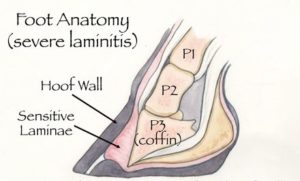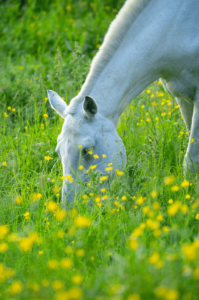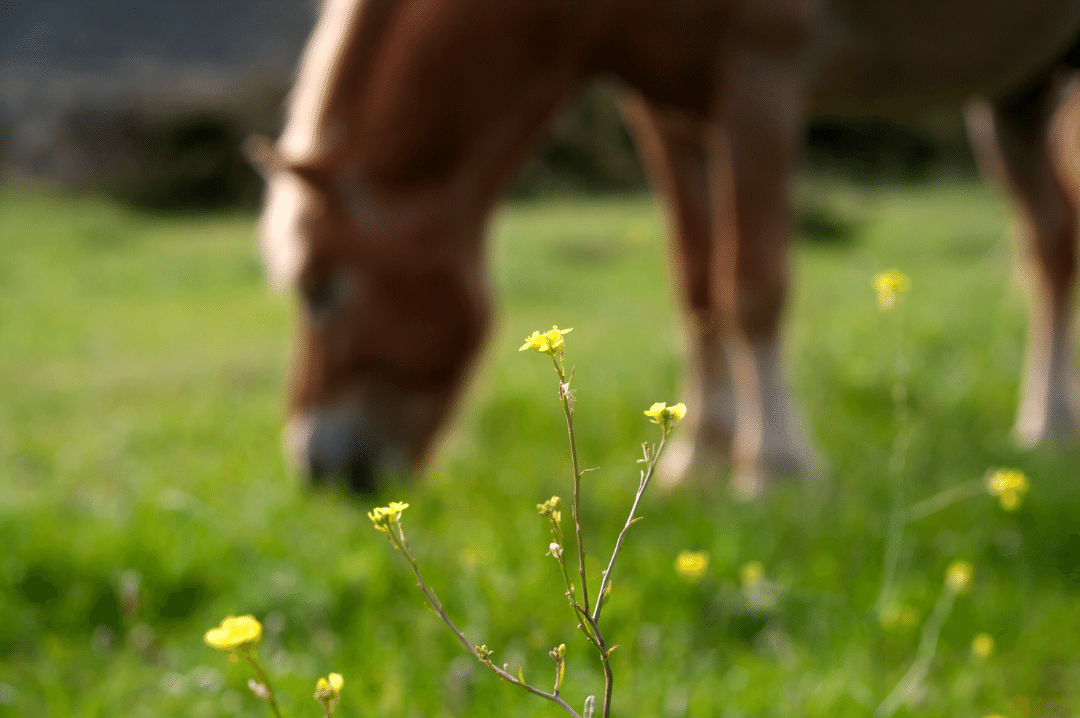
13 May 2022 Laminitis in Horses
With spring comes warmer temperatures which allow for fresh grass to grow. For many horses, it’s finally a time to be able to be turned out again on a more regular basis. But be aware, with this spring grass also comes the danger of Laminitis in horses. This condition has several causes, but sudden access to lush forage or high amounts of sugars from grasses is one of the main dangers. What is it, and how can you prevent Laminitis in your horse?
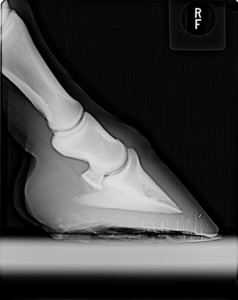
An example of a healthy hoof, no rotation
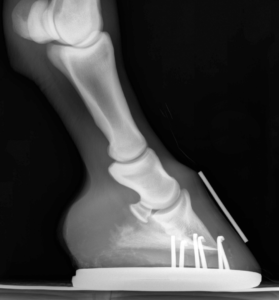
An example of a laminitic hoof, bad rotation
What is Laminitis?
Laminitis is literally inflammation of the laminae. The laminae are the structures within the hoof, which secure the coffin bone (the wedge-shaped bone in the hoof of the horse) to the hoof wall. When blood flow to those structures interrupted, inflammation can occur, resulting in a weakening, frequently permanently, of the hoof wall and coffin bone.
In situations where this inflammation is prolonged, the hoof wall can actually be separated from the coffin bone and the coffin bone my rotate downward (sink) and possibly protrude through the sole of the foot. Laminitis can affect one or all four feet, but is most commonly found in both front feet. It is an extremely painful condition for the horse and when not caught in time, it is irreversible and may lead to the death of the horse.
What Causes Laminitis?
There are multiple causes of laminitis, but certain events may leave a horse more pre-disposed than others. Sometimes the underlying cause is often a disturbance elsewhere in the body and not in the feet themselves.
– Digestive upsets due to grain overload or abrupt changes in diet (excess grain, fruit, treats)
– Sudden access lush forage before the horse’s system has had time to adapt (“grass founder”)
– Toxins released within the horse’s system
– High fever or illness which may cause metabolic disturbances
– Severe colic
– Retained placenta in the mare after foaling
– Excessive concussion to the feet (“road founder”)
– Excessive stress on a leg due to injury to another part of body
– Bedding that contains black walnut shavings (safe bedding replacement here)
– Prolonged use or high doses of corticosteroid medications
Risk Factors
Some horses seem to be more predisposed than other and more susceptible to Laminitis because of either
– A previous history of inflammation
– Being a heavy breed
– Being overweight
– Being on a diet with a lot of sugars and carbohydrates
– Accidental unrestricted access to grain, or
– Older horses with Cushing’s disease. See our guide on feeding older horses.
Warning Signs of Laminitis
When you find your horse presents itself with sudden lameness, reluctance to move, or stiffness when starting to move, it’s wise to check for
– Heat in the front feet
– Increased digital pulses
– Increased heart rate
– Pain in the toe region when you apply pressure with hoof testers
– Walking very hesitantly or reluctantly
– Widened white line (seedy toe) because the laminae are separating from the walls
– Increased insulin levels
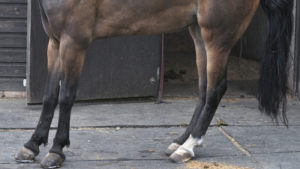 In more severe cases, horses will stand parked out with their front feet in front of them and hind legs underneath them, trying to get the weight off the front feet. In a stall you may notice this stance accompanied by bedding being pushed up in an angle, so they can take the pressure off the feet and the tendons and ligaments pulling on the coffin bone from within the leg.
In more severe cases, horses will stand parked out with their front feet in front of them and hind legs underneath them, trying to get the weight off the front feet. In a stall you may notice this stance accompanied by bedding being pushed up in an angle, so they can take the pressure off the feet and the tendons and ligaments pulling on the coffin bone from within the leg.
In any of these cases it is important to immediately call your veterinarian for further assistance.
In the meantime, you may try to cool the feet with ice or cold hosing, your vet may recommend you immediately administer anti-inflammatory medication as well. Take the horse off any feed, grain or hay until the veterinarian arrives to give you further instructions and a plan of action depending on the severity of the condition.
Don’t overlook the warning signs, because time is of the essence to avoid severe or permanent damage.
Role of Nutrition in Laminitis
Most cases of Laminitis are due to nutrition, especially sudden changes in diet, such as being turned out on spring grasses such contain a lot more nutrients than winter grasses.
Disturbances in the gut can often be traced back to changes in gut motility or bacterial flora. The horse was designed to be a grazer, continuously ingesting small quantities of forage. How your horse’s digestive system works. High quantity rations for high performance can lead to potential complications and compromise the absorption process in the hindgut. The amount of fiber in the diet is paramount so that the population of bacteria in the hind gut and the absorption is maximized.
Rapidly growing new grass has highly soluble carbohydrates, particularly fructans. Grasses store energy in the form of fructan in the stems, leaves and seed heads, especially during the spring when the days are warm and sunny, and the plant gets more energy than it can use. This stored fructan is then used on cloudy days or at night to continue growth. Therefore, the amount of fructan found in grass is usually lowest just before dawn and peaks around noon. You can lower your horse’s exposure to too much fructan by turning them out in the morning on spring days and bringing them in early.
When horses ingest large quantities of fructan, it can stimulate overgrowth of bacteria in the large intestine. These bacteria then produce toxins, or endotoxins, that end up in the bloodstream, eventually reaching the laminae of the hoof and causing inflammation.
How to Treat Laminitis
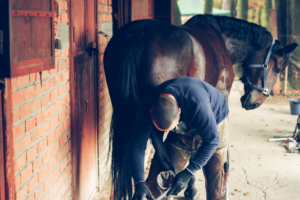 The sooner the diagnose and treatment can begin, the higher the chances are for a complete recovery, but many factors will play a role.
The sooner the diagnose and treatment can begin, the higher the chances are for a complete recovery, but many factors will play a role.
Dietary restrictions are a very important part in this recovery but as with many other conditions, prevention is key. After initial first aid, radiographs are an important instrument in arming the hoof care specialist with information for appropriate intervention.
Reducing the effect of the deep digital flexor tendon on the coffin bone is also good practice. It is the pull of this, in opposition to the loss of tensile strength of the laminal bond that causes rotation of the coffin bone. If your horse gets diagnosed with laminitis, working with your vet, farrier, and nutritionist all together will be your best chance for a full recovery.
Nutrition
Nutritional treatment specifically aims to decrease the absorption of endotoxins from the gastrointestinal tract and to repopulate the bacterial flora of the hind gut. Increasing the time feed is going through the hind gut is key. This happens through increased fiber content which is digested much more slowly as well as lowering the acid levels in the colon through taking away readily digestible starches and sugars and replacing them by digestible fiber. This will help to repopulate the hind gut with normal bacterial flora.
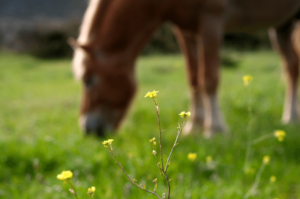 In Short
In Short
In short, it’s important horses have access to fiber which is digested more slowly or to reduce the intake of sugar rich forage such as fresh grass. You can accomplish this by limiting the time horses spend on the fresh grass, changing the time of day they do go out (turn out at night or early morning) or slowing them down by wearing a grazing muzzle.
Even in the middle of summer when sudden showers and milder temperatures allow for sudden grow spurts in grass, it is necessary to be vigilant and apply the same measures.
Cutting the grass to an appropriate length (minimum of 6 inches) is also needed, so grass is not ‘damaged’ through cutting it too short, allowing these sugars to get to the tips of the blades much faster. Overgrazing your pastures needs to be watched, as not only is the grass below the ideal six inch length, it will also allow for weeds to take over, changing the variable of the forage intake even further.
Learn more about your horse’s digestive system and nutrition needs.
Contact me for help with your horse’s nutrition!
